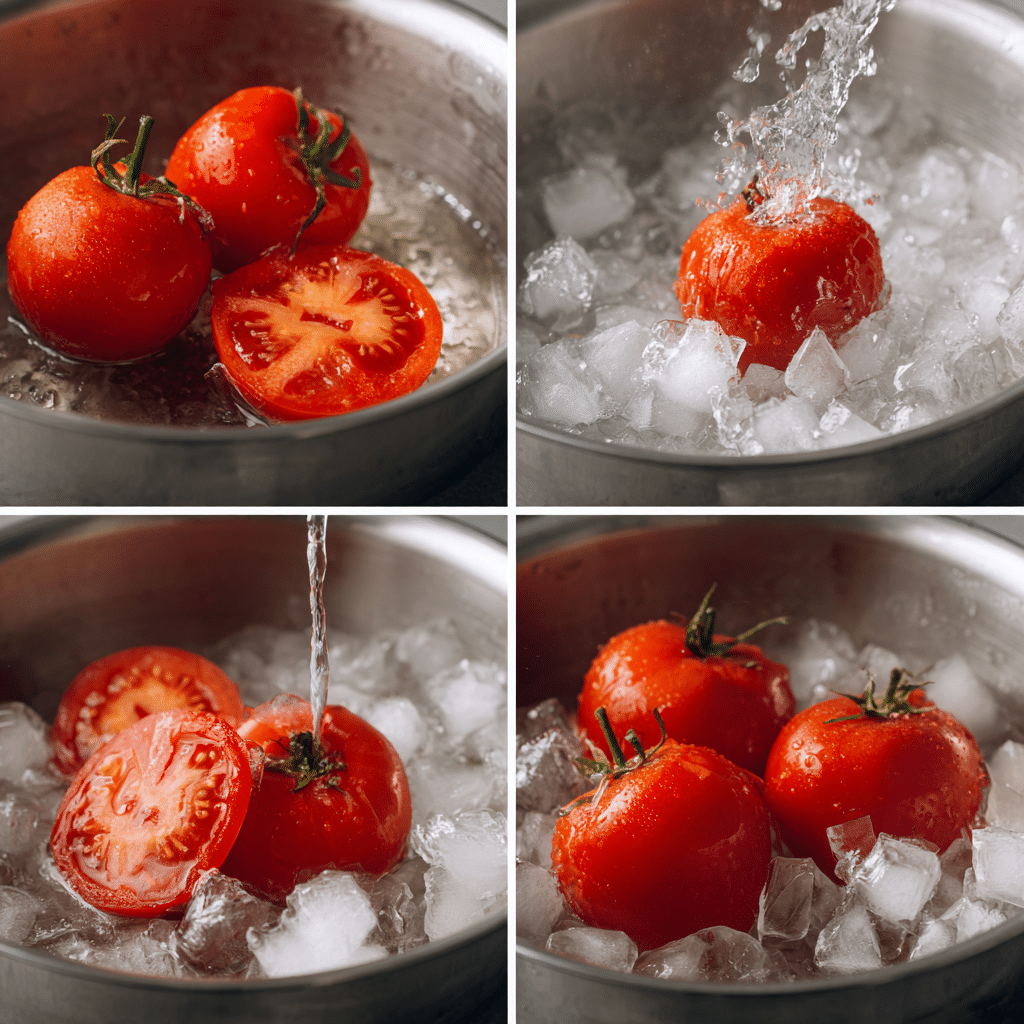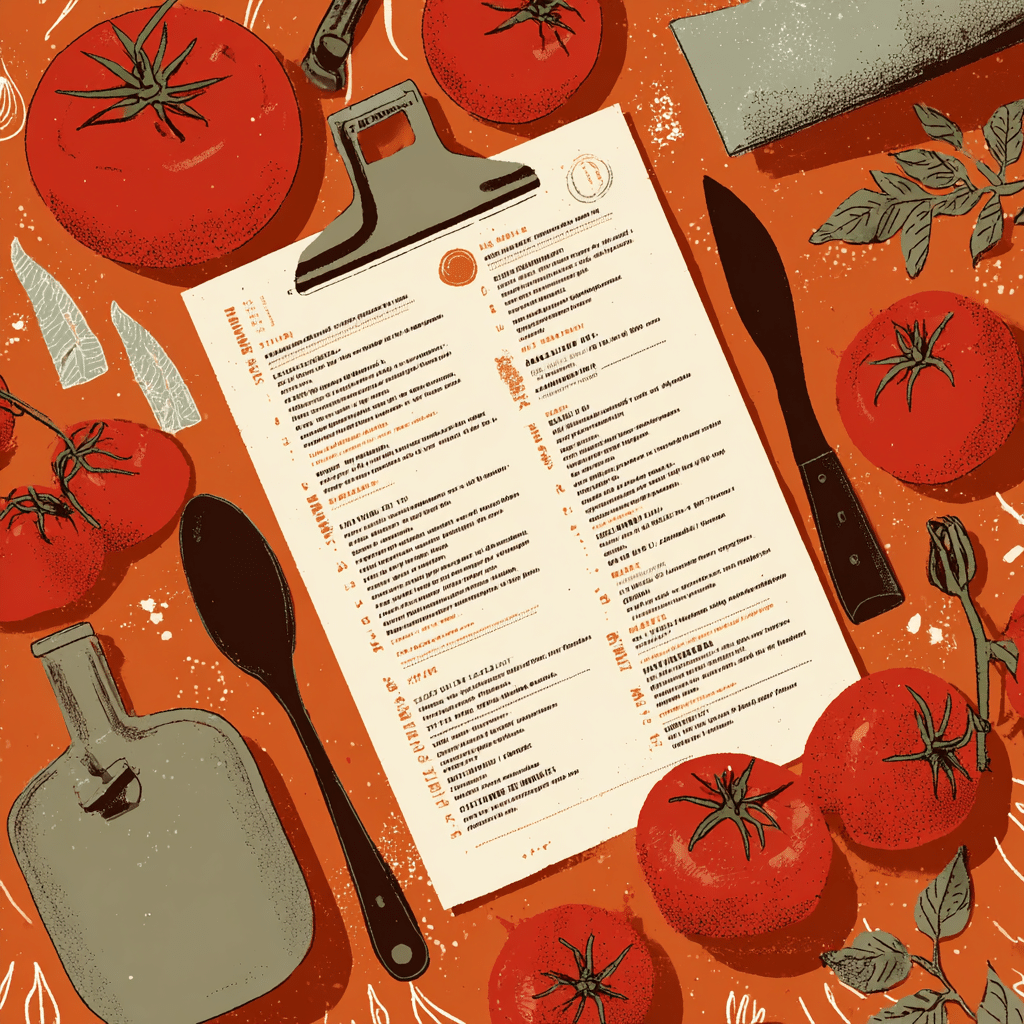If you’ve ever wondered how to peel tomatoes without making a mess, you’re not alone. One summer afternoon, I set out to make my grandma’s Sunday sauce, only to realize I had no canned tomatoes—just fresh ones from the garden. Her handwritten recipe clearly said, “Use peeled tomatoes.” I quickly learned how to peel tomatoes the old-fashioned way, and it’s been a go-to skill ever since. Whether I’m prepping for sauce, stew, or canning, knowing how to peel tomatoes properly saves time and improves texture.
You don’t need a fancy tool or a culinary degree to learn how to peel tomatoes at home. In fact, the best methods rely on simple steps that bring big results. Peeling your own tomatoes means you control the flavor, skip the preservatives, and create better dishes—like Pappa al Pomodoro or my garden-fresh
Print
How to Peel Tomatoes Fast (No Fuss, No Fancy Tools)
Description
Learn how to peel tomatoes using simple kitchen techniques like blanching, freezing, or microwaving. Great for sauce, canning, or everyday cooking.
Ingredients
Ripe tomatoes
Paring knife
Slotted spoon
Ice water
Large pot
Tongs
Microwave (optional)
Instructions
Bring a pot of water to boil and prepare a bowl of ice water.
Score a shallow X on the bottom of each tomato.
Boil tomatoes for 30–60 seconds or until skins begin to loosen.
Transfer tomatoes into the ice water bath immediately.
Peel off the skins using your fingers or a small knife.
Optional: Use freezing or microwave method for no-boil peeling.
Store peeled tomatoes in jars or freezer bags as needed.
Notes
Use ripe tomatoes for best results.
Don’t skip the ice bath—it helps release the skin easily.
Microwave or freezer methods are better for small batches.
Table of Contents
The Traditional Method – Blanching Tomatoes for Peeling
Quick and Classic: The Boil-and-Shock Method

One of the easiest ways to master how to peel tomatoes is the classic boil-and-shock technique. Start by bringing a pot of water to a boil. While that’s heating, score a small “X” on the bottom of each tomato. This helps the skin loosen. Fill a bowl with ice water and set it aside.
Drop your tomatoes into the boiling water for just 30 to 60 seconds. The skin will start to curl at the edges. Then, use a slotted spoon to move them into the ice bath. The rapid chill helps separate the skin so it slides off easily.
If you’re working on a big batch—maybe prepping for homemade sauce or freezing—this method is ideal. I always use it before canning or before a slow-cooked tomato base like in my stuffed pasta shells.
Tools You’ll Need: Simple and Handy

To know how to peel tomatoes efficiently, all you need is a pot, ice, a sharp knife, and a bowl. Tongs or a slotted spoon help with handling the tomatoes safely. You don’t need any special gear, and it works with cherry or beefsteak tomatoes alike.
One thing I’ve learned: don’t skip the ice water. That cold shock is key to getting clean, skin-free tomatoes without bruising or waste. Once you get the hang of it, peeling becomes second nature—almost like muscle memory every time you’re making a sauce from scratch.
How to Peel Tomatoes Without Boiling
Raw and Ready: The Knife & Spoon Trick
If you’re in a rush or just not in the mood to boil water, you can still figure out how to peel tomatoes using a paring knife and spoon. Start by slicing a shallow “X” at the bottom of each tomato, then pop it into the freezer for about 20 to 30 minutes. Once it chills, take it out and let it sit at room temperature for a few minutes. The skin contracts and often starts to split naturally.
At that point, use a small spoon to gently wedge under the skin and lift it off. A sharp paring knife helps with any stubborn bits. This method works best with ripe, softer tomatoes and is ideal when you’re making something like tomato confit or prepping a small batch for breakfast shakshuka.
It’s not as quick as blanching in large batches, but it’s a solid trick for when your stove is full or you just want to keep things simple. It’s also how I start some slow-roasted dishes like roasted tomato soup when I want full control over ingredients.
Microwave Method: Fast but Effective
Another lesser-known way to learn how to peel tomatoes is by using the microwave. Slice the skin lightly (just like the blanching method) and microwave the tomato on high for about 30 seconds. Let it cool just enough to handle, and you’ll notice the skin has loosened in spots. From there, it peels off with minimal effort.
This trick is surprisingly handy when you’ve only got one or two tomatoes to peel. It saves you from heating an entire pot of water. Just don’t overcook—30 seconds is usually enough.
Microwaving is especially useful if you’re prepping for a quick homemade salsa or a tomato-heavy stir-fry where you want the flavor of fresh tomatoes without the bite of the skins.
Whether you’re working on a large Sunday sauce or a simple weekday meal, these no-boil techniques give you more freedom in the kitchen while still teaching you how to peel tomatoes like a pro.
Making Peeled Tomatoes at Home for Storage
Batch Prep: Peel and Store for Later

Once you know how to peel tomatoes easily, it opens the door to prepping ahead for busy seasons. If your garden (or farmers market) gives you more tomatoes than you can use in a week, peeling and storing them is the way to go. Start with your preferred peeling method—blanching is still the best for large volumes.
After peeling, core the tomatoes and either leave them whole, halve them, or crush them by hand. Place the tomatoes in clean jars or freezer bags. If you’re freezing, make sure to leave about an inch of space at the top since tomatoes expand when frozen. If canning, follow standard safety procedures and consider adding lemon juice for acidity balance.
I do this every August, and by winter I’ve got the base for chili, soup, or baked ziti ready to go without ever opening a can. The flavor stays richer, and I avoid that tinny taste store-bought tomatoes sometimes bring.
Canned vs. Frozen: What Works Best?
Once you’ve nailed how to peel tomatoes, the next step is choosing how to store them. Canning is best for shelf-stable storage. You can process peeled tomatoes in a water bath canner or pressure canner, depending on your recipe. Be sure to use sterilized jars and lids, and always follow current USDA guidelines.
Freezing, on the other hand, is easier and perfect for beginners. Just pack your peeled tomatoes into labeled freezer bags, press out the air, and stack them flat for space-saving storage. I usually freeze tomatoes that I’ll use in stews, like my Tuscan white bean stew, where texture doesn’t matter as much after simmering.
You can even roast your peeled tomatoes with garlic and olive oil before freezing to add more flavor right out of the freezer bag. No matter how you store them, once you understand how to peel tomatoes efficiently, your pantry possibilities grow.
Conclusion
Learning how to peel tomatoes isn’t about being fancy—it’s about flavor, texture, and making your kitchen life easier. Whether you go the traditional route with boiling or opt for a stoveless shortcut, knowing how to peel tomatoes gives you more control over your recipes and a deeper connection to the food you’re making.
From Sunday sauces to winter stews, having peeled tomatoes on hand changes how you cook. And once you’ve done it a few times, it’s second nature. The trick is picking the method that fits your time, tools, and taste. So grab those garden-fresh beauties or that farmers market haul and get peeling—you’ll be amazed at the difference.
for more Recipes follow me in facebook
FAQS
What is the easiest way to remove skin from tomatoes?
The easiest way is the boil-and-shock method. Just score the tomato, boil it briefly, then move it to ice water. The skin will slide right off with minimal effort.
Can I peel a tomato without boiling?
Yes. You can freeze tomatoes for 20–30 minutes, then let them sit briefly before peeling. Or, microwave them for about 30 seconds. Both methods loosen the skin without using the stove.
How to make peeled tomatoes at home?
Peel your tomatoes using any preferred method, then store them in freezer bags or canning jars. They can be crushed, chopped, or left whole, depending on how you plan to use them.
Do I need to peel tomatoes for sauce?
For smooth sauces, yes. Peeling avoids the tough, bitter bits of skin. But for rustic, blended, or roasted sauces, you can skip it if you’re short on time or like the texture.




